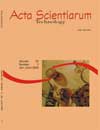Environmental weakness in the river Keller basin, Paraná: a study on erosion processes
DOI:
https://doi.org/10.4025/actascitechnol.v23i0.2798Keywords:
fragilidade ambiental, processos erosivos, bacia do rio KellerAbstract
The methodology for the study of environmental fragility of the relief-soil relationship with regard to the river Keller basin. Research demonstrates the repercussion on the erosive processes in areas with basalt substrata influenced by mesothermic climate (types Cfa, Cfah) of the Kí¶eppen classification. A classification of the basin of river Keller's environmental fragility is proposed, based on the laboratory analysis of different soil horizons and field works, using pocket penetrometer (which measures penetration resistance to each horizons) and surface and subsurface infiltrometer. Procedures lead us to comprehend the environmental fragility (relations relief-soil, use of land/vegetation) and show the classes most likely to host erosion processes (less stable) and the ones that are less likely to do so (more stable). Results demonstrate low environmental fragility, inherent to high tops in the amigdaloidal basalt (0%-6% of declination), with red latisol, clay structure, coffee or temporary cultures; correlation with textural classes with clay and heavy clay, with fast or very fast infiltrometer readings, which could lead to erosion processes converging to the laminar erosion; medium environmental of slopes (0%-12%, 12%-20% of declination), which have amigdaloidal basalt, with structured (red nitosol), or massive basalt with underdeveloped soils; land use is characterized by temporary cultures or pasture; textural classes: loam-clay-silty, loam-silty and very fast infiltrometer readings (underdeveloped soils), very slow (red nitoso); in the latter, the erosive processes will converge to gullied incisions; high environmental fragility in the slopes of high declination (20%-30%, >30%) and bottom of valleys and fluvial lowlands, composed of massive basalt or of amigdaloidal basalt recovered by underdeveloped soils, (river organosol or neosol) used as pasture; textural classes loam-clay-silty, clay-silty, loam-silty; very fast sub-superficial infiltrometer readings (underdeveloped soils), slow (river neosol); erosive processes linked to slidings, collective soil movements, gullied incisions, ravines and gullies. Production of thematic maps, scale 1:50.000 (hypsometric, clinographic, geological, geomorphological of shapes associated with actual erosive processes, of soils, use of land/vegetation, environmental fragility of the relation relief/soil), allied to laboratory analysis and to field experiments are fundamental data for the studies of environmental planning. These procedures are important for the comprehension of erosion dynamics and diagnosis and prognostics with an aim to preserve the environmentDownloads
Download data is not yet available.
Downloads
Published
2008-05-05
How to Cite
Reis Nakashima, M. da S. (2008). Environmental weakness in the river Keller basin, Paraná: a study on erosion processes. Acta Scientiarum. Technology, 23, 1547–1560. https://doi.org/10.4025/actascitechnol.v23i0.2798
Issue
Section
Geography
License
DECLARATION OF ORIGINALITY AND COPYRIGHTS
I Declare that current article is original and has not been submitted for publication, in part or in whole, to any other national or international journal.
The copyrights belong exclusively to the authors. Published content is licensed under Creative Commons Attribution 4.0 (CC BY 4.0) guidelines, which allows sharing (copy and distribution of the material in any medium or format) and adaptation (remix, transform, and build upon the material) for any purpose, even commercially, under the terms of attribution.
Read this link for further information on how to use CC BY 4.0 properly.











8.png)




